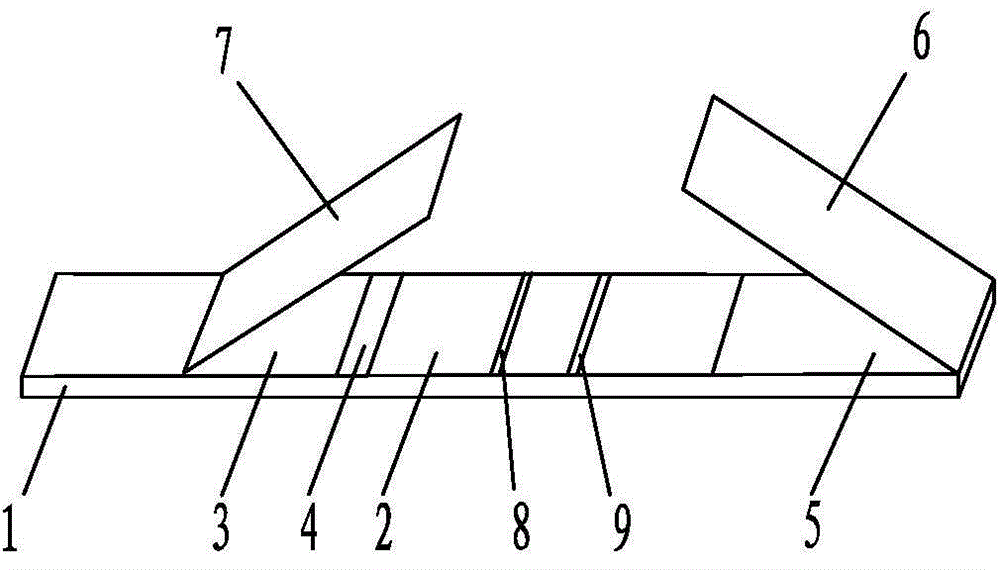Preparation method for pathogenic yersinia enterocolitica test strips
A technology of enterocolitis and Yersinia, which is applied in the field of biomedicine, can solve the problems of poor specificity, tediousness, time-consuming detection methods, etc., and achieve the effect of rapid typing detection and sensitive typing detection
- Summary
- Abstract
- Description
- Claims
- Application Information
AI Technical Summary
Problems solved by technology
Method used
Image
Examples
Embodiment 1
[0023] In concrete implementation, the present invention is realized by the following steps:
[0024] (1) Preparation of purified monoclonal antibodies:
[0025] Take 1 part of mouse ascites and 3 parts of acetate buffer with pH 4.4, add 100 μl of n-octanoic acid dropwise for each ml of ascites, mix well, place at room temperature at 18-25°C for 30 minutes, and centrifuge at 15,000 rpm at 4°C For 20 minutes, discard the precipitate, adjust the pH value of the supernatant to 7.2 with NaOH, then add ammonium sulfate, the amount of ammonium sulfate added is 0.277g per ml of supernatant, stir at room temperature at 18-25°C for 30 minutes, 15000 rpm Separate and centrifuge at 4°C for 20 minutes, discard the supernatant, and dissolve the precipitate with a pH7.2 PBS solution that is 1 / 2 times the volume of the mouse ascites, and then put it into a pH7.2 PBS buffer as a dialysate Medium, 48 hours of dialysis at 4°C, changing the dialysate every 9-10 hours to produce purified monoclo...
Embodiment 2
[0035] In concrete implementation, the present invention is realized by the following steps:
[0036] (1) Preparation of purified monoclonal antibodies:
[0037] Take 1 part of mouse ascites and 3 parts of acetate buffer with pH 4.4, add 100 μl of n-octanoic acid dropwise for each ml of ascites, mix well, place at room temperature at 18-25°C for 25 minutes, and centrifuge at 15,000 rpm at 4°C After 15 minutes, discard the precipitate, adjust the pH value of the supernatant to 7.2 with NaOH, then add ammonium sulfate, the amount of ammonium sulfate added is 0.277g per ml of supernatant, stir at room temperature at 18-25°C for 25 minutes, 15000 rpm Separate and centrifuge at 4°C for 15 minutes, discard the supernatant, and dissolve the precipitate with 1 / 2 volume of PBS solution with pH 7.2 as the ascites of the mouse, and then put it into the PBS buffer with pH 7.2 as the dialysate , dialysis at 4°C for 45 hours, changing the dialysate every 9-10 hours to make purified monoclo...
Embodiment 3
[0047] In concrete implementation, the present invention is realized by the following steps:
[0048] (1) Preparation of purified monoclonal antibodies:
[0049] Take 1 part of mouse ascites and 3 parts of acetate buffer with pH 4.4, add 100 μl of n-octanoic acid dropwise for each ml of ascites, mix well, place at room temperature at 18-25°C for 35 minutes, and centrifuge at 15,000 rpm at 4°C After 25 minutes, discard the precipitate, adjust the pH value of the supernatant to 7.2 with NaOH, then add ammonium sulfate, the amount of ammonium sulfate added is 0.277g per ml of supernatant, stir at room temperature at 18-25°C for 35 minutes, 15000 rpm Separate and centrifuge at 4°C for 25 minutes, discard the supernatant, and dissolve the precipitate with 1 / 2 volume of PBS solution with pH 7.2 as the ascites of the mouse, and then put it into the PBS buffer with pH 7.2 as the dialysate , dialysis at 4°C for 50 hours, changing the dialysate every 9-10 hours to make purified monoclo...
PUM
 Login to View More
Login to View More Abstract
Description
Claims
Application Information
 Login to View More
Login to View More - Generate Ideas
- Intellectual Property
- Life Sciences
- Materials
- Tech Scout
- Unparalleled Data Quality
- Higher Quality Content
- 60% Fewer Hallucinations
Browse by: Latest US Patents, China's latest patents, Technical Efficacy Thesaurus, Application Domain, Technology Topic, Popular Technical Reports.
© 2025 PatSnap. All rights reserved.Legal|Privacy policy|Modern Slavery Act Transparency Statement|Sitemap|About US| Contact US: help@patsnap.com

